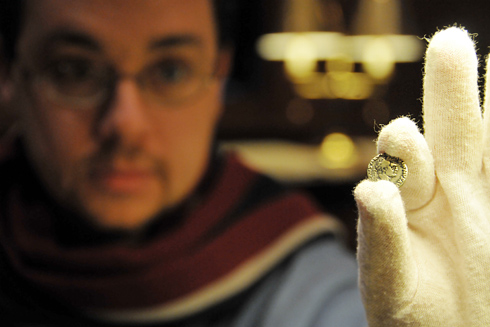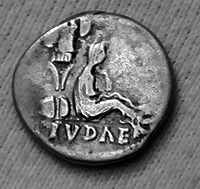Jewish Community Donates Roman Coin to Special Collections

In 70 C.E., Roman Emperor Vespasian and his son, Titus, sacked the city of Jerusalem, destroying the Jewish temple.
To commemorate the success of quelling the Jewish Revolt, the Romans minted a series of nearly 50 “Judea Capta” (Captured Judaea) coins in gold, bronze and silver to remind the Roman Empire of its victory. Most of these coins depict a Roman soldier or leader, outfitted in military attire, and a mourning female Jewish woman, seated under a palm tree or trophy.
On Jan. 14, Jewish Chaplain Rabbi David Teva Leipziger Teva, director of religious and spiritual life, donated a silver coin, known as a denarius, to Wesleyan’s Special Collections and Archives. The silver denarius, featuring an embossed profile of Emperor Vespasian and the words “Caesar Vespasianus Avg(ustus),” was struck in 69-70 A.D.

“The coin was probably minted at a time when the teaching of Judaism and outward expressions of biblical, temple cult-based Judaism were made impossible by a dominating power,” Rabbi Leipziger Teva says. “Fast forward to 2010 at Wesleyan. Today we have multiple creative pathways for students to express and explore their Judaism and their Jewish identities. This coin talked about the complete opposite of all of this.”
Suzy Taraba, university archivist and head of Special Collections and Archives, says the denarius is the first coin donated to Wesleyan in at least 12 years. The coin will be housed with another Roman coin of the 15th century, which is embossed with the first, regularly used printer’s mark.
Taraba encourages faculty teaching courses on religion or history to use the coins as teaching tools. Jewish history scholar Magda Teter, associate professor of history, says she’d use the coin in her HIST 247 class to discuss the destruction of Jerusalem following the Jewish rebellion in 70 C.E., the complexity of continuing Jewish life in Judea in the aftermath of the rebellion that resulted in the destruction, and the final expulsion from the area in the aftermath of yet another rebellion against Rome in 132 C.E.
“I could present the coin, alongside later responses to the destruction from the Jewish side, and look at the meaning of the year 70 C.E,” Teter says. “The meaning was significant for both Rome and the Jews, and this coin was a part in a series of coins minted for 25 years to commemorate the event. Such commemorative coins were common in the Roman Empire, they were often minted to spread news,’ since coins moved with traders.
Rabbi Leipziger Teva acquired the coin from Daniel and Luellen Lucid P’10 of Santa Monica, Calif.
“We feel that seeing and touching something historical is an important part of learning about history,” Luellen Lucid explains. “We’ve collected coins over the years and have donated them if they have some historical interest, so we are pleased if there is an opportunity for classes to use it as part of a Wesleyan education.”
The Lucids purchased the coin in February 2006 from an auction company in Beverly Hills, Ca. and donated the coin and an informational booklet to Wesleyan’s Jewish community in 2008.
“Wesleyan began as a primarily Methodist institution, with very few Jewish students on campus,” explains Valerie Gillispie, assistant university archivist. “The Jewish population has grown in time, and now we have a great deal of diversity within our students, staff and faculty.”

